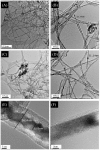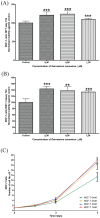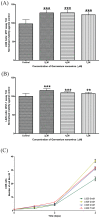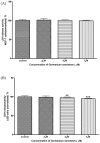Promoting cell proliferation using water dispersible germanium nanowires
- PMID: 25237816
- PMCID: PMC4169628
- DOI: 10.1371/journal.pone.0108006
Promoting cell proliferation using water dispersible germanium nanowires
Abstract
Group IV Nanowires have strong potential for several biomedical applications. However, to date their use remains limited because many are synthesised using heavy metal seeds and functionalised using organic ligands to make the materials water dispersible. This can result in unpredicted toxic side effects for mammalian cells cultured on the wires. Here, we describe an approach to make seedless and ligand free Germanium nanowires water dispersible using glutamic acid, a natural occurring amino acid that alleviates the environmental and health hazards associated with traditional functionalisation materials. We analysed the treated material extensively using Transmission electron microscopy (TEM), High resolution-TEM, and scanning electron microscope (SEM). Using a series of state of the art biochemical and morphological assays, together with a series of complimentary and synergistic cellular and molecular approaches, we show that the water dispersible germanium nanowires are non-toxic and are biocompatible. We monitored the behaviour of the cells growing on the treated germanium nanowires using a real time impedance based platform (xCELLigence) which revealed that the treated germanium nanowires promote cell adhesion and cell proliferation which we believe is as a result of the presence of an etched surface giving rise to a collagen like structure and an oxide layer. Furthermore this study is the first to evaluate the associated effect of Germanium nanowires on mammalian cells. Our studies highlight the potential use of water dispersible Germanium Nanowires in biological platforms that encourage anchorage-dependent cell growth.
Conflict of interest statement
Figures







Similar articles
-
PEGylation of carboxylic acid-functionalized germanium nanowires.Langmuir. 2010 Sep 7;26(17):14241-6. doi: 10.1021/la102124y. Langmuir. 2010. PMID: 20698505
-
Epitaxial growth of InP nanowires on germanium.Nat Mater. 2004 Nov;3(11):769-73. doi: 10.1038/nmat1235. Epub 2004 Oct 10. Nat Mater. 2004. PMID: 15475961
-
Template assisted electrodeposition of germanium and silicon nanowires in an ionic liquid.Phys Chem Chem Phys. 2008 Nov 7;10(41):6233-7. doi: 10.1039/b809075k. Epub 2008 Sep 5. Phys Chem Chem Phys. 2008. PMID: 18936846
-
Stranski-Krastanow growth of germanium on silicon nanowires.Nano Lett. 2005 Jun;5(6):1081-5. doi: 10.1021/nl050605z. Nano Lett. 2005. PMID: 15943447
-
A review on germanium nanowires.Recent Pat Nanotechnol. 2012 Jan;6(1):44-59. doi: 10.2174/187221012798109291. Recent Pat Nanotechnol. 2012. PMID: 22023079 Review.
Cited by
-
Recent Advances in Nanomaterials of Group XIV Elements of Periodic Table in Breast Cancer Treatment.Pharmaceutics. 2022 Nov 29;14(12):2640. doi: 10.3390/pharmaceutics14122640. Pharmaceutics. 2022. PMID: 36559135 Free PMC article. Review.
-
A Review of Self-Seeded Germanium Nanowires: Synthesis, Growth Mechanisms and Potential Applications.Nanomaterials (Basel). 2021 Aug 4;11(8):2002. doi: 10.3390/nano11082002. Nanomaterials (Basel). 2021. PMID: 34443831 Free PMC article. Review.
-
Aligned microchannel polymer-nanotube composites for peripheral nerve regeneration: Small molecule drug delivery.J Control Release. 2019 Feb 28;296:54-67. doi: 10.1016/j.jconrel.2019.01.013. Epub 2019 Jan 15. J Control Release. 2019. PMID: 30658124 Free PMC article.
-
Engineered nanoparticle bio-conjugates toxicity screening: The xCELLigence cells viability impact.Bioimpacts. 2020;10(3):195-203. doi: 10.34172/bi.2020.24. Epub 2020 Mar 24. Bioimpacts. 2020. PMID: 32793442 Free PMC article. Review.
References
-
- Chan CK, Zhang XF, Cui Y (2008) High Capacity Li Ion Battery Anodes Using Ge Nanowires. Nano Letters 8: 307–309. - PubMed
-
- Huang J-S, Hsiao C-Y, Syu S-J, Chao J-J, Lin C-F (2009) Well-aligned single-crystalline silicon nanowire hybrid solar cells on glass. Solar Energy Materials and Solar Cells 93: 621–624.
-
- Canham LT, Newey JP, Reeves CL, Houlton MR, Loni A, et al. (1996) The effects of DC electric currents on the in-vitro calcification of bioactive silicon wafers. Advanced Materials 8: 847–849.
Publication types
MeSH terms
Substances
LinkOut - more resources
Full Text Sources
Other Literature Sources

